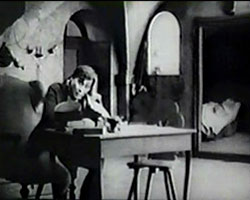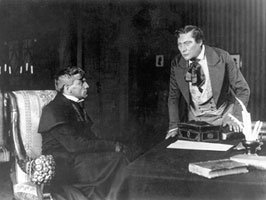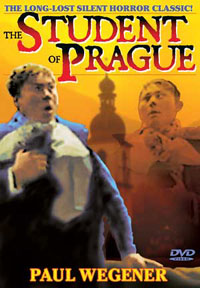Though The Student of Prague (Der student von Prag, 1913) was inspired by Edgar Allan Poe's tale "William Wilson" & E. T. A. Hoffmann's "Die Abenteuer der Sylvesternacht" ("The New Year Eve's Adventure"; aka, "The Lost Reflection"), borrowing mainly the doppelganger ingredients. Too little of either story remains to call it a Poe story, or a Hoffmann story, having been fully transformed into a version of Faust by way of .
 In 1821, Balduin (Paul Wegener in a bit of vanity-casting; he's really too old & flabby for the role of young duelist) is Prague's best student & finest young swordsman. He is weary of being penniless. So he strikes a diabolical pact with a sorcerer (John Gottowt in his first film). In 1821, Balduin (Paul Wegener in a bit of vanity-casting; he's really too old & flabby for the role of young duelist) is Prague's best student & finest young swordsman. He is weary of being penniless. So he strikes a diabolical pact with a sorcerer (John Gottowt in his first film).
The sorcerer is in fact the Devil, though unfortunately there's a bit of borrowing from stage plays about evil Jews in the way the Scapinelli character is played & visually represented (the scenario was written by horror novelist H. H. Ewers, later to prove himself indeed a Nazi sympathizer).
The tale was set in Prague after all, the City of Jews, & of kabbalah, so it was natural enough to Faganize the make-up design for the devil in Prague. Director Paul Wegener soon after co-directed Der Golem (1914) & played the titular role with considerable sensitivity. But as a Catholic he was not sufficiently sensitive to the stereotype perpetrated in The Student of Prague.
The actor who sustained the Devil Jew role was himself a Jew, best remembered for having played the Van Helsing type character in Nosferatu (1922). For being Jewish, Gottowt was killed by the SS in Poland in 1942.
 In exchange for good fortunate, the sorcerer will claim any payment he desires of Balduin, hardly proving the student's intellilgence. In exchange for good fortunate, the sorcerer will claim any payment he desires of Balduin, hardly proving the student's intellilgence.
The price of course is his soul, & Balduin thereafter lacks a reflection in mirrors. This lost reflection will later seem to have taken on a separate life of its own, with the purpose of doing harm.
Not surprisingly, in the long run Balduin gains very little for his soul, not that it could ever have been worth very much. He behaves attorciously before & after his contract, & right up to his demise fails to be a figure worthy of salvation.
Though frequently misrepresented as a precursor to German Expressionism, there is nothing about the design of the film to suggest any influence on Expressionist films of the 1920s, though such design can certainly be seen in Der Golem, likely Wegener's greatest film. The Student of Prague did strongly impact the vastly improved remake in 1926, which is indeed Expressist.
The 1913 version is of itself no lost treasure reclaimed; Mellies was filming Faust stories just as good ten years sooner. Only the significance of the director's other works makes Student a must-see, & the fact of its early date making it of the first generation of horror films.
The Alpha Video dvd release seems to be missing scenes & is further afflicted with an obnoxious organ score (really a faked organ on Paul David Bergel's blithering synthesizer). This score seems to be performed by a malfunctioning robot chimp incapable of referencing what's on the screen.
copyright © by Paghat the Ratgirl
|

 In 1821, Balduin (Paul Wegener in a bit of vanity-casting; he's really too old & flabby for the role of young duelist) is Prague's best student & finest young swordsman. He is weary of being penniless. So he strikes a diabolical pact with a sorcerer (John Gottowt in his first film).
In 1821, Balduin (Paul Wegener in a bit of vanity-casting; he's really too old & flabby for the role of young duelist) is Prague's best student & finest young swordsman. He is weary of being penniless. So he strikes a diabolical pact with a sorcerer (John Gottowt in his first film). In exchange for good fortunate, the sorcerer will claim any payment he desires of Balduin, hardly proving the student's intellilgence.
In exchange for good fortunate, the sorcerer will claim any payment he desires of Balduin, hardly proving the student's intellilgence.